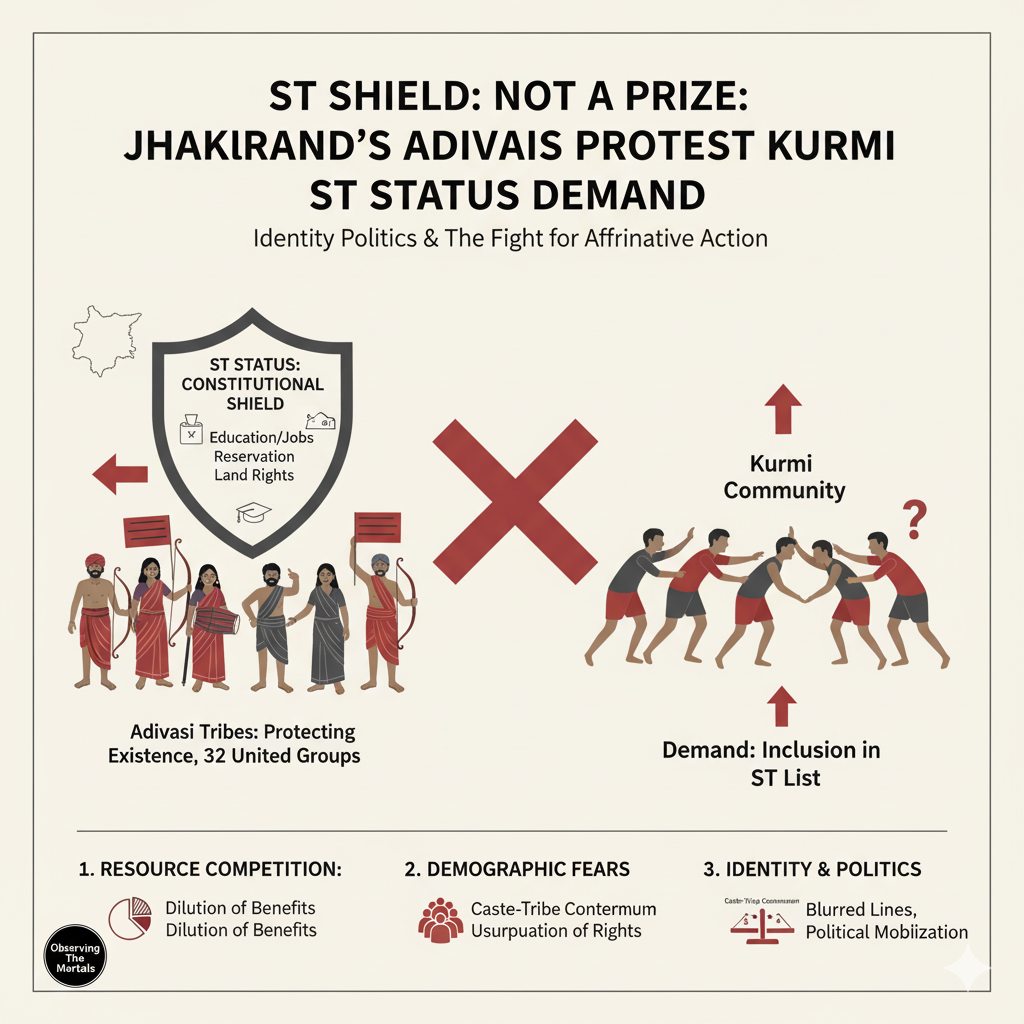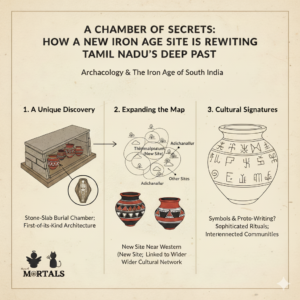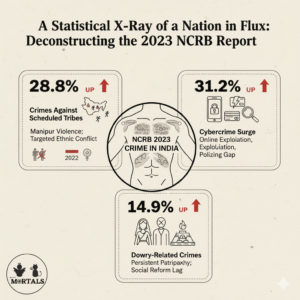The designation of “Scheduled Tribe” in India is not merely an identity marker; it is a constitutional shield, designed to protect the rights, resources, and unique cultures of the nation’s most historically marginalized indigenous communities. But what happens when another large, politically organized community demands to be included under this protective umbrella? In Ranchi, Jharkhand, thousands of Adivasis from 32 different tribes have taken to the streets in an ‘Akrosh Maharally’ (Rally of Rage). This case study delves into a high-stakes conflict that is not just about historical claims, but about present-day anxieties and what one leader calls a “battle to protect the tribal existence.”
The Information Box
Syllabus Connection:
- Paper 2: Chapter 6.1 (Problems of Tribal Communities), Chapter 9.3 (Tribal Movements, Ethnic Conflict), Chapter 3.1 (Caste-Tribe Continuum)
- Paper 1: Chapter 4 (Political Anthropology: Ethnicity, Identity Politics, State), Chapter 2.5 (Social Stratification)
Key Concepts/Tags:
- ST Status, Kurmi Community, Adivasi, Identity Politics, Ethnic Conflict, Resource Competition, Jharkhand, Caste-Tribe Continuum
The Setting: Who, What, Where?
The setting is Ranchi, the capital of Jharkhand, a state with a significant tribal population. The central event is the ‘Akrosh Maharally,’ a massive protest rally organized and participated in by members of the state’s 32 recognized tribal communities. The protest is a direct and forceful reaction against the long-standing and intensifying demand by the Kurmi (Mahto) community to be granted Scheduled Tribe (ST) status. Key actors include tribal leaders and organizations like the Kendriya Sarna Samiti.
The Core Argument: Why This Study Matters
This conflict is a critical case study on the politics of affirmative action and the contested nature of identity in modern India.
- ST Status as a Scarce and Protected Resource: The core of the conflict lies in the perception of ST status as a scarce and finite resource. The tribal protestors argue that this status is a constitutional shield that grants them access to vital, protected benefits: reservations in government jobs and education, political representation in legislatures, and special land rights (like the Chotanagpur Tenancy Act in Jharkhand) designed to prevent alienation.
- The “Threat” of Demographic Disruption: The fundamental fear articulated by tribal leaders is that the inclusion of the large, demographically strong, and politically organized Kurmi community into the ST list would be a demographic and political catastrophe for the existing tribes. They believe it would dilute their share of the reservation pie, challenge their political representation, and weaken their land rights—in essence, as one leader put it, a “conspiracy to usurp their constitutional rights.”
- The Politics of Recognition and Pan-Tribal Unity: This event showcases two key political processes. First, it is a battle for state recognition, where the Kurmis are lobbying the state to change their classification, and the Adivasis are mobilizing to prevent it. Second, this external threat has become a powerful catalyst for pan-tribal unity. The rally saw 32 distinct tribal groups, each with its own unique culture and language, coming together under a single, unified political identity—”Adivasi”—to defend their shared interests.
The Anthropologist’s Gaze: A Critical Perspective
- The Caste-Tribe Continuum in Action: This conflict is a perfect, real-world illustration of the classic anthropological concept of the caste-tribe continuum. The Kurmi community occupies an ambiguous position on this spectrum. Historically an agricultural/peasant caste (currently classified as OBC in many states), they are now making historical and cultural claims to an indigenous, non-caste, tribal identity. This fundamentally challenges the neat, rigid administrative boundaries that the state has drawn between “caste” and “tribe.”
- “Tribalization” as a Political Strategy: An anthropologist would analyze the Kurmi demand as a form of social mobility that is the reverse of “Sanskritization.” Instead of trying to move up the caste hierarchy, the community is engaged in a process of “tribalization”—seeking to exit the caste fold entirely to gain entry into the ST category. This is a modern political strategy aimed at accessing the significant constitutional benefits attached to the ST status.
- Affirmative Action and Inter-Group Conflict: This case highlights an unfortunate and often unintended consequence of affirmative action policies. By creating protected categories with tangible benefits, the state can inadvertently create a “zero-sum game” environment, where marginalized groups are pitted against each other in a fierce competition to either protect their share of the benefits or gain access to them.
The Exam Angle: How to Use This in Your Mains Answer
- Types of Questions Where It can be Used:
- “The distinction between ‘caste’ and ‘tribe’ in India is often blurred and politically contested. Discuss.”
- “Analyze the causes and nature of contemporary tribal movements in India.”
- GS-2: “The implementation of reservation policies in India has led to new social and political conflicts. Analyze.”
- Model Integration:
- On the Caste-Tribe Continuum (Paper 2): “The concept of the caste-tribe continuum is vividly illustrated by the ongoing conflict in Jharkhand, where the Kurmi community’s demand for ST status is being fiercely opposed by existing tribal groups. This highlights how historically fluid identities are now being hardened in a political battle over the legal definition of ‘tribe’.”
- On Tribal Movements: “Contemporary tribal movements are often defensive in nature, aimed at protecting their constitutional rights from perceived threats. The ‘Adivasi Akrosh Rally’ in Ranchi against the inclusion of the Kurmis in the ST list is a prime example of a pan-tribal mobilization to safeguard their share of reservations and land rights.”
- For a GS-2 Answer: “The policy of reservation, while designed for social justice, has also become a source of inter-community conflict. The agitation by tribal groups in Jharkhand against the Kurmi community’s demand for ST status shows how the classification of communities can lead to a zero-sum competition for scarce resources and political representation.”
Observer’s Take
The rally in Ranchi is a powerful and poignant demonstration of what is at stake when identity becomes a currency for state-mandated benefits. For the Adivasi communities, the ST status is not a prize to be won, but a shield for survival, forged in a long history of struggle and marginalization. The protest is a desperate cry to prevent that shield from being stretched so thin that it shatters. This conflict is a crucial reminder that the administrative act of classifying people is never a neutral one; it is a deeply political process that can forge unexpected alliances, create new battle lines, and force entire communities to fight for their very existence in the public square.





